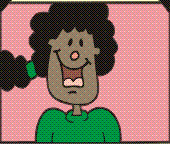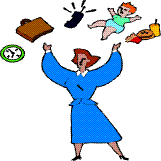to ADD
Home
About Sarah Jane
About ADHD
How does ADHD feel?
What does the research say?
Women and ADHD
Take the test
What is Pseudo ADHD?
Mabel Retires witn ADD
Coaching for ADHD
Stories
Resources
What you can do
Services
Contact me
Subscribe
Zebra stripes
my free newsletter
Inattentive and HyperactiveWomen with Attention Deficit Disorder (AD/HD, ADD)
"Now, here, you see, it takes all the running you can do, to keep in the same place. If you want to get somewhere else, you must run at least twice as fast as that!" said the Queen
What does it mean for a woman to have Attention Deficit Disorder, hyperactive or inattentive type?
Much public talk about Attention Deficit Disorder with or without Hyperactivity Disorder (AD/HD) centers on the hyperactivity part, but the hyperactivity is, in fact, the lesser of the two problems. Early research focused on the boys who were disruptive in school, and early statistical evalutaions concluded that boys were more often affected than girls.
More recent research has focused on the ADHD Inattentive type, and now doctors know that girls and women are more often affected by the Attention Deficit Inattentive type. Furthermore that girls, even when hyperactive, don't present the same public symptoms as boys.
What is the difference between Attention Deficit with Hyperactivity and Attention Deficit - Inattentive Type?
Sari Solden in her book Women with Attention Deficit Disorder summarizes the principle differences in a table.
| Symptom | ADHD Inattentive type | ADHD Hyperactive |
| Attention | Daydreamming, Lost in an inner world, Does one thing at a time | Highly distracted by outer stimulation, Does many things at once |
| Activity Level | Hypo-active, Works and thinks slowly, Can't start moving | Hyperactive, Rushes through work, Can't stop moving |
| Impulsivity | Quiet, excessive , shifting of activities, life directions | Acting out impulses without pre-thinking |
How do girls differ from boys?
Girls tend to fit into one of four profiles, none of which rivals the boys in their noisy, disruptive behavior.
 Julia, a hyperactive girl, likes to play with her brothers, climb trees, and run about, but at home she is generally calm and likes to please her Daddy. People call her a "tom boy". She tries hard at her school work, though she is messy and often incomplete, and her mediocre school results are accepted as the best effort she is capable of.
Julia, a hyperactive girl, likes to play with her brothers, climb trees, and run about, but at home she is generally calm and likes to please her Daddy. People call her a "tom boy". She tries hard at her school work, though she is messy and often incomplete, and her mediocre school results are accepted as the best effort she is capable of.
Donna, an inattentive girl, sits at the back of the class room and is often staring out the window, but when her teacher calls on her she smiles sweetly and makes a big effort to do as she is told. At other times she appears to be paying attention, but in reality she is quite lost, unable to follow what the teacher is saying. She works more slowly than others in her class and usually fails to finish work assigned. But because she is cooperative and sweet, no one suspects that she has a problem. She is just naturally "dreamy" or "spacey".
Susan, another hyperactive girl, talks and talks and giggles, often thinking about the next recreation or a weekend party. When she tries to relate events, she tends to be very disorganized, jumping about from the beginning to the end and back again. She is fun to be with because she bubbles with enthusiasm and ideas, but gets extremely upset when anyone disagrees with her. She is hyper-talkative and hyper-emotional and may act "silly" to disguise her disorganization and forgetfulness. As she gets older her hyperactivity may lead her into risky experimenting with cigarettes, drugs or sexual adventure to compensate for her poor school performance.
ideas, but gets extremely upset when anyone disagrees with her. She is hyper-talkative and hyper-emotional and may act "silly" to disguise her disorganization and forgetfulness. As she gets older her hyperactivity may lead her into risky experimenting with cigarettes, drugs or sexual adventure to compensate for her poor school performance.
Deborahinattentive, did very well in school even obtaining a PhD and an excellent job. Although she had worked very hard to achieve her academic success, much harder than her peers, her attention problems did not really become evident until she married and had children. Then the sheer complexity of life with work, husband and children led to a severe depression.
Hyperactive boys are likely to get the support they need because they are disruptive, while girls are mostly better behaved so they do not attract attention. The attention they do get is less likely to focus on the learning problem then on the character problem: Julia is not lady like, Susan is a social butterfly not an academic, Donna is just a bit slow, and Deborah has a touch of the baby blues. AD/HD is rarely considered.
What happens when girls grow up?
Many children with Inattentive ADHD grow up to be adults with Inattentive ADHD. The symptoms you might see in adults include disorganization, emotional reactivity, under-achievement, low self-esteem, impaired relationships, or depression; of these disorganization ranks as the most pervasive.
Disorganization can take on mythic proportions. Disorganization means overflowing cupboards, piles of stuff with baby piles, missed meetings, chronic lateness, befuddled thinking all related to an erratic attention system.
One woman reports having so many things to do and not knowing where to start so she just sits down. Sari Solden herself tells how when working as a therapist, she would bring her paper work home every weekend to "get organized".
In addition, there is the frustration and shame of finding so difficult what others do so easily, the feeling of abandonment as colleagues and friends move on with their lives while you seem to be trapped like Sisyphus forever organizing papers which instantly disorganize. The others stop asking what are you doing these days? Because the answer is always the same "organizing".
Job Description : Wife, Mother
Women with ADD are doubly handicapped by the social expectations put on them in their feminine roles as wife and mother, roles which require a high degree of organization.
For a moment, consider what attention deficit disorder means. You are familiar with dimmers, these gizmos which allow you to adjust the brightness of a lamp: low and sultry for an evenings cuddle but high for a serious work session. Brains need an electric current to function just like your lamp. In ADHD brains, poor use of dopamine in the synapse acts just like a dimmer. ADD brains are effectively operating with insufficient current, so they need stimulation to turn up the power. Novelty and risk are ways ADHD people can wake up.
ADD brains are effectively operating with insufficient current, so they need stimulation to turn up the power. Novelty and risk are ways ADHD people can wake up.
Back to our house wife who is faced everyday with the same thousand things to do, the same dishes to put in the dish washer, take out of the dish washer; the same dirty socks to collect wash , pair up to put away, the same shirts to iron, etc. It's all boring. Then there are the children to clothe, feed, get out the door, take to the doctor or the tennis lesson, social engagements to organize. There's that word again: "organize". Deciding what to do first or which is most important or remembering to pick up the dry cleaning requires an active brain, but the ADD brain is functioning with the dimmer on minimum.
Susan who escaped school as fast as possbile felt equally a failure as a housewife.
At work, life may or may not be more congenial. If a woman like Deborah, with a PhD, has a job which challenges her abilities and builds on her interest, she may thrive. Another woman shines as a strategic planner but doesn't know how to clear up after dinner.
Women like Julia or Donna who have difficulty in school are more likely to find low level jobs which like house work demand the very skills they lack: filing, typing neatly without errors, or remembering customers orders in a restaurant.
The work place often requires a great deal of socializing which may be difficult for someone like Donna who lives in her own world or even Susan the socialite who tends to be emotive or Julia with her "Tom boy" style who may find herself shunned by both men and women. And Deborah may be "too" intelligent.
What Next? Turning up the dimmer
For anyone, men and women, with Attention Deficit Disorder (ADHD), knowledge is the first step to change. Learn what turns the lights up in your brain. What interests you? Make room in your life for activities which work for you. Have some fun.
Learn to ask for help. Medication and coaching as discussed elsewhere on this Web site provide external aids which have helped many people with AD/HD to recreate their lives.
If you would like to know more about ADHD coaching, try a session for free. Send me an email at Sarah Jane. Put "Free coaching session2 in the subject line and mention times when you are available.
To learn more about ADHD: